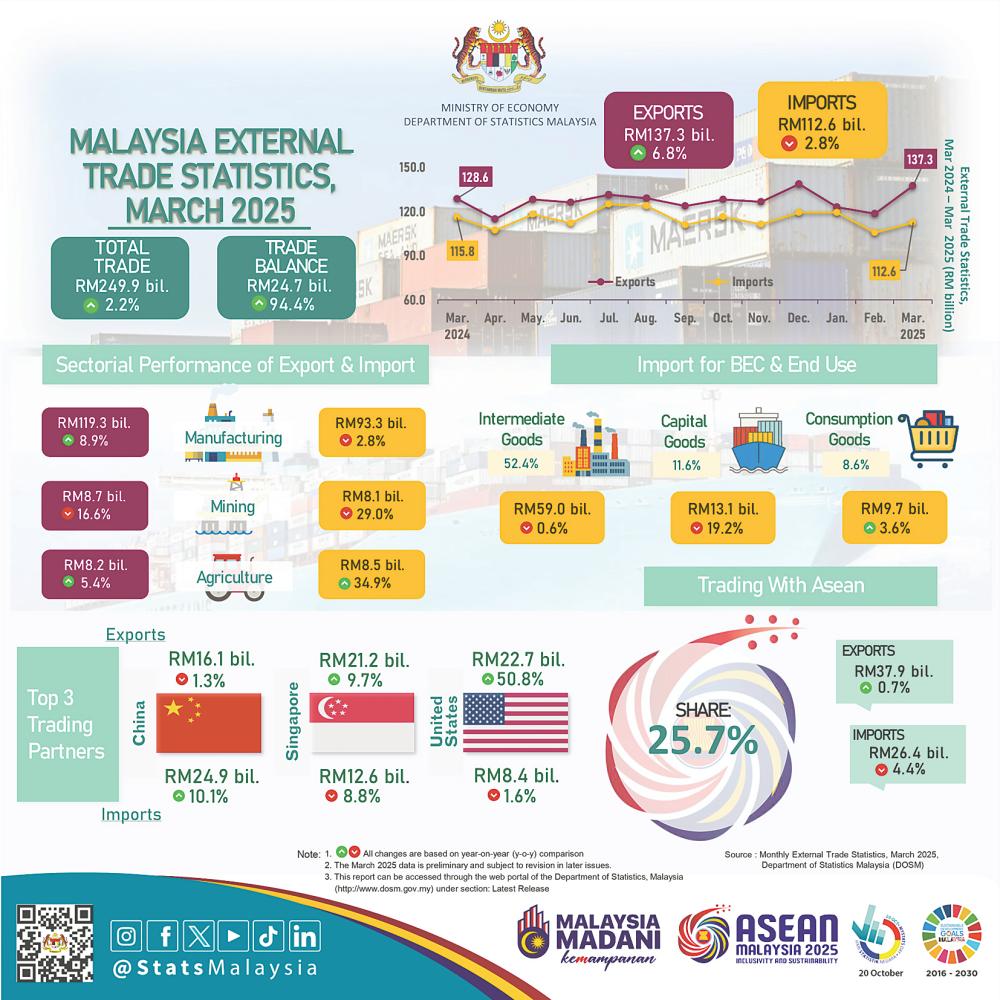PETALING JAYA: Malaysia’s trade performance in March 2025 reflected resilience with a steady increase in exports, while a decline in imports highlighted challenges amid broader economic uncertainties.
Total trade experienced a year-on-year (y-o-y) growth of 2.2% to RM249.9 billion, attributable to a steady growth in exports (+6.8%) to RM137.3 billion. However, imports experienced a decrease by 2.8% or RM3.3 billion to RM112.6 billion.
The trade balance demonstrated stronger performance, with the surplus rising by 94.4% to RM24.7 billion in March, the Department of Statistics Malaysia said in its monthly external trade statistics report. It marked the 59th consecutive month of surplus since May 2020.
Chief Statistician Malaysia Datuk Seri Dr Mohd Uzir Mahidin said Malaysia’s export growth in March was driven by increases in both domestic exports and re-exports. Domestic exports, which accounted for 80% of total exports, rose by 5.6% to RM109.9 billion, while re-exports, making up 20% of total exports, expanded by 12.1% to RM27.4 billion
compared to March 2024.
Month-on-month, March 2025 demonstrated growth over February 2025, with exports, imports, total trade up by 16.1%, 6.6%, 11.6%, respectively, and the trade balance surged 96%.
In terms of commodity group, 113 out of 257 export groups showed an increase while 137 out of 260 import groups showed a decrease compared to the same month of the previous year.
Mohd Uzir said higher exports were attributable mainly to the United States (+RM7.6 billion), followed by Hong Kong (+RM1.9 billion), Singapore (+RM1.9 billion), Taiwan (+RM1.6 billion), the European Union (+RM1 billion), the Philippines (+RM498.7 million) and South Africa (+RM339 million).
Nevertheless, sluggish imports were mainly contributed by shipments from Taiwan (-RM1.7 billion), followed by India (-RM1.5 billion), the United Arab Emirates (-RM1.3 billion), Singapore (-RM1.2 billion), Australia (-RM799.9 million), Thailand (-RM715.2 million) and Qatar (-RM544.9 million).
Commenting further on exports, Mohd Uzir said the increase was reflecting the rise in electrical & electronic products (+RM12.5 billion); machinery, equipment & parts (+RM785.3 million); condensates & other petroleum oil (+RM619.1 million); processed food (+RM542.7 million); other manufactures (+RM524.1 million); and palm oil-based manufactured products (+RM512 million).
Meanwhile, the drop in imports was mainly attributed to petroleum products (-RM6.6 billion); crude petroleum (-RM1.7 billion); manufactures of metal (-RM1 billion); other mining (-RM1 billion); iron & steel products (-RM846.3 million); and liquefied natural gas (-RM592.8 million).
Mohd Uzir underscored the upsurge in imports by end-use which was in accordance with slower demand for capital goods and intermediate goods. Imports of capital goods (11.6% of total imports) decreased by 19.2% or RM3.1 billion to RM13.1 billion.
Imports of intermediate goods (52.4% of total imports), valued at RM59 billion, registered a marginal decrease of 0.6% or RM350.1 million compared to March 2024. However, imports of consumption goods (8.6% of total imports), was up by 3.6% or RM342.4 million to reach RM9.7 billion.
As for performance for the first quarter of 2025, total trade, exports, imports and trade surplus increased compared to the same period last year. The encouraging economic performance led to a 3.6% rise in total trade, aligning with the increase in exports (+4.4%) and imports (+2.8%). The trade surplus amounted to RM41 billion, an increase of 20.1% compared to the same period in 2024.









